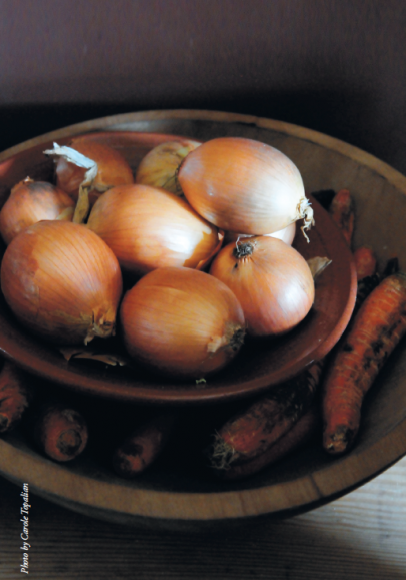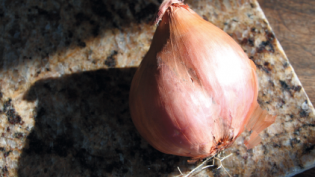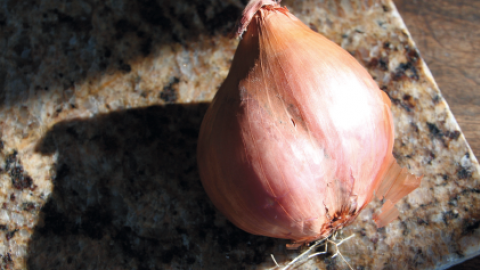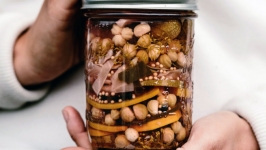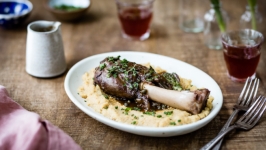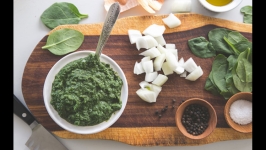Seasonal Eats: Alliums
Take a stroll through a bustling farmers’ market this time of year and chances are it will contain the familiar feel of its summertime counterpart, yet a whole different tonal quality has emerged. The autumnal colors of the foliage match the food, and the allium family leads the way. You’ll find displays of bronze and purple onions, plump white leeks and red-skinned garlic, alongside shallots and flat topped cippolini onions.
Garlic swags and bushels of papery yellow onions are the more familiar members of this tribe of plants, which embraces over 400 species of rhizomarous or bulbous plants. Cousin to asparagus and tulips, this ancient bulb onion is rich in culinary history and offers more nutrition than meets the eye. What better time than now to expand your recipe repertoire and stock up on this healthiest of fall vegetables.
Chefs call alliums “aromatics” because they impart a fragrance as well as flavor to any dish. Similar to potatoes or apples, each allium brings its own personality to the table. Sweet leeks softened in butter or olive oil add depth to stews, soups, and quiche. Gently braised or grilled Walla Walla onions (our northern version of Vidalia) are great paired with a burger or steak. Assertive Italian Red Torpedo onions are at their best when roasted in a hot oven, then tossed with pasta. Shallots are flexible enough to be sautéed, braised, glazed, and caramelized, leaving garlic to be blended into a smooth pesto.
When Hippocrates said “Let food be thy medicine and medicine be thy food,” he was no doubt holding his wine glass up to honor the noble onion. Throughout history, garlic, onions, and the whole allium family have been celebrated as lifesaving medicine. Hunter-gatherers and Native Americans knew the value of wild ramps and used them to treat infected wounds and restore appetites among the ill. Wild alliums are more pungent than their domesticated cousins, and for this reason, they contain far more “allicin,” the ingredient responsible for the highly touted antioxidant, antibacterial and anticancer qualities of onions.
It’s a time-honored tradition in many kitchens to start every meal with some type of allium sizzling in the pan, while the cook rummages the refrigerator in search of inspiration for what to make for dinner. But according to Jo Robinson, Author of “Eating on the Wild Side”, many of the conventional ways of cooking garlic can destroy most of its health benefits.
It takes only two minutes in a frying pan to reduce garlic to little more than flavor. Allicin is created when two substances in garlic, which are separated by a membrane, commingle. This happens when you press or chew the garlic, and the combustion begins. Heating the garlic immediately after crushing or slicing it will destroy this heat sensitive enzyme that triggers the allicin.
To reap the benefits of garlic you must follow the ten minute rule: chop, mince, slice or mash the garlic and then keep it away from the heat for ten minutes. After that, you can sauté or add the garlic to any dish and be guaranteed to get the full benefit of its medicinal qualities. If you seek maximum antioxidant qualities from your basic onion, choose the hotter and darker skinned types over mild and white, which are typically low in sulphur and therefore sweeter. If it brings tears to your eyes when you are slicing and dicing, you know you have made a nutritionally sound choice. The papery skin also contains natural compounds that retain a high concentration of bio-nutrients, which makes them the most nutritional part of the vegetable. Although eating skins is not recommended, save them to enrich broth for soups.
When you shop for onions at a farmers’ market, look for the red skinned varieties, flat topped heirloom cippolinis, leeks with plenty of green (the most nutritious part) and shallots, which are becoming more popular in specialty markets and among gardeners because they grow easily and fast. Ounce for ounce, shallots have six times more phytonutrients than a typical onion, and twice as much quercetin, a natural antiviral that keeps away flus and colds.
Shopping for fall and winter food involves slowing down, and alliums are here to help. Scatter them around a roast or baked chicken, braise for a robust side dish or try this shallot timbale for a richly flavored accompaniment to a special occasion meal. Stock up on alliums because they store well in a cool dry basement, and will reward you with good health all winter long. Like aged cheese and wine, the onion family is essential to good cuisine.


